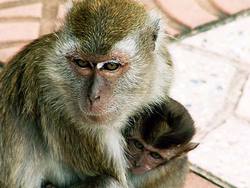 Numbers of live Long-tailed Macaques in trade rose markedly after 2004 Click image to enlarge August 2011—The trade in Long-tailed Macaques was one of the issues under scrutiny at the Animals Committee meeting of CITES (The Convention on International Trade in Endangered Species of Wild Fauna and Flora) that took place this July.
Numbers of live Long-tailed Macaques in trade rose markedly after 2004 Click image to enlarge August 2011—The trade in Long-tailed Macaques was one of the issues under scrutiny at the Animals Committee meeting of CITES (The Convention on International Trade in Endangered Species of Wild Fauna and Flora) that took place this July.
The CITES Animal Committee provides the technical and scientific basis for the sustainability of international trade in live specimens, parts and derivatives from over 4,500 species of animals.
The Committee heard about a rapid surge in international trade in the Long-tailed Macaque Macaca fascicularis since 2004.
Most of the macaques are traded live for use in biomedical research, and originate mainly in China, Indonesia and Cambodia.
Of all the mammals listed in the CITES Appendices, the Long-tailed Macaque is the species most traded in live form.
Listing in the various Appendices of CITES governs their international trade: the macaque is listed in Appendix II, meaning trade is permissible, but is strictlycontrolled and can only take place with the appropriate documentation and permits.
Graphic depicting the trade in live Long-tailed Macaques reported by CITES PartiesNumbers of macaques reported by CITES Parties in trade increased from around 17,000 animals per year in 2004 to around 37,000 by 2006 before decreases in 2007 and 2008 to a figure of around 28,000.
The macaque trade was among a number of issues of wildlife trade concern examined by a record number of more than 200 delegates representing 50 countries attended the annual Animals Committee meeting of the Convention.
The Committee also examined the sustainability of current levels of trade in skins of three species of snakes used in luxury products—the Oriental Rat Snake Ptyas mucosus, Reticulated python Python reticulatus and Indonesian cobra Naja sputatrix and largely endorsed recommendations identified in an earlier snake trade workshop held in China that included tightening the controls on snake-breeding facilities and the supply chain for the skin trade.
How stocks of sturgeons and paddlefish in the Caspian Sea are assessed was also reviewed, with the Committee recognizing that insufficient expertise in the region was a major impediment to implementing conservation measures.
The eggs of these fish species are in high demand as caviar, which has led to over-fishing of wild sturgeons. Azerbaijan, Iran and other range States announced a moratorium on wild sturgeon fishing for 2011.
Other topics examined included the ongoing concern over the status of sharks—several shark species are heavily over-fished, largely to meet demand from the fin trade. The fins are a highly prized ingredient in sharks fin soup, a popular dish, particularly in East Asia.
Trade in several Malagasy endemic species, including chameleons and frogs, and seahorses from Southeast Asia, were also identified as priorities for further action.
Further details of the Animals Committee meeting, and its outcomes can be found on the CITES website.